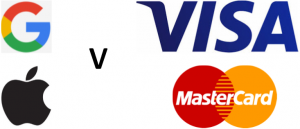Should Visa and MasterCard be scared of Apple and Google?
 If Visa and MasterCard are the toll roads for payments between consumers and merchants, then Apple Pay and Android (Google) Pay are the new class of on-ramps. The risk for Visa and MasterCard is that Apple and Google eventually activate the corresponding exits that deliver payments from the payers (consumers) to the payees (merchants) and then use their own toll roads to carry the traffic (payments) instead of the traditional toll roads owned by Visa and MasterCard.
If Visa and MasterCard are the toll roads for payments between consumers and merchants, then Apple Pay and Android (Google) Pay are the new class of on-ramps. The risk for Visa and MasterCard is that Apple and Google eventually activate the corresponding exits that deliver payments from the payers (consumers) to the payees (merchants) and then use their own toll roads to carry the traffic (payments) instead of the traditional toll roads owned by Visa and MasterCard.
Apple has some 800m global iTunes users as of late 2015 and iTunes is both an on-ramp and Apple toll road which could potentially be used to deliver payment to another iTunes user without needing to traverse the traditional Visa / MasterCard networks. Currently Apple Pay is more than happy to focus on driving consumers to use its on-ramp technology at the point-of-sale to deliver payment to the merchant using the traditional card scheme networks. So Visa and MasterCard are willing accomplices because they still benefit from their traditional revenues even while having to pay Apple a fee in exchange for access to the Apple on-ramp.
Android Pay employs a similar model to Apple’s. It’s an on-ramp technology to the traditional toll roads. It could potentially become an exit ramp too, but for now it is happy to drive consumer acceptance at the point-of-sale and use the card scheme networks for transport.
In Australia, Google has won support from many of the major banks who act as both issuers and acquirers of Visa and MasterCard as well as the domestic “eftpos” debit network. This gives Google a distinct advantage over Apple whose users can only participate using American Express acting as both issuer and acquirer. This means that Apple’s eligible market is limited only to AMEX cardholders and merchants. Google’s market consists of all merchants that accept Visa, MasterCard and eftpos and all cardholders of the participating Visa, MasterCard and eftpos issuers. This is a much bigger pool than the one Apple is swimming in. Also, Android has a 55% market share compared to Apple iOS’ 38% in the three months to October 2015.
The Australian banks have also spurned Apple’s overtures because Apple has sought a larger share of the interchange fee that the acquirer pays to the issuer via Visa and MasterCard than is commercially viable. US issuers have more interchange to share and so have been able to accomodate Apple’s proposals, but the market dynamics in Australia are different and much less fragmented than in the US.
The Apple deal with AMEX in Australia also reflects AMEX’s greater ability to meet Apples’s demands (due to higher fee revenue from merchants compared to Visa and MasterCard) as well as AMEX’s more urgent need to innovate to remain competitive with Visa and MasterCard. The most recent earnings forecast for 2016 has disappointed market analysts and AMEX’s revenues in 2015 have fallen each quarter, further demonstrating ongoing challenges to AMEX’s business strategy.
In the US, Apple Pay and Android Pay are actually helping Visa and MasterCard buttress their defences against CurrentC, an initiative involving Walmart, Best Buy and other large retailers to develop an “inter-network” between themeselves to disintermediate the traditional payments networks. This is because retailers need to support Apple and Android Pay as acceptance methods, and in doing so, are delivering payments to the Visa and MasterCard toll roads. If consumers vote with their phones, then Visa and MasterCard win for as long as they remain the toll roads for the Apple and Android on-ramps.
It’s been reported that Apple will earn 0.15% of the value of every Apple Pay transaction in the USA. The Bank issuers will fund this from their interchange they receive from Visa and MasterCard acquirers for acceptance processing. Some media reports infer that this is a modest fee, but it’s comparable to the net acquiring margin that is derived in some cases, especially from larger merchants. It represents a not insignificant proportion of interchange, and will be a material source of new revenue for Apple if Apple Pay is widely adopted.
Google is understood not to be claiming a cut of interchange, or if it is, not as much as Apple. In Australia, this is one of the reasons why Android Pay has been supported by a number of banks. This approach may be more successful in time than Apple’s if it leads to greater ubiquity and transaction volume.
So the alliance between Apple / Android and the traditional payments toll road owners looks like a symbiotic one for now, and perhaps for the foreseeable future? But the investment in on-ramp technology now could prove very lucrative in the longer term if they decide to displace the banks and card schemes and collect all of the tolls instead.
At least until one of the emerging fintech startups builds something shinier and newer!
Update February 2017 – get the latest on the Apple stoush with the Aussie banks and retailers here.
